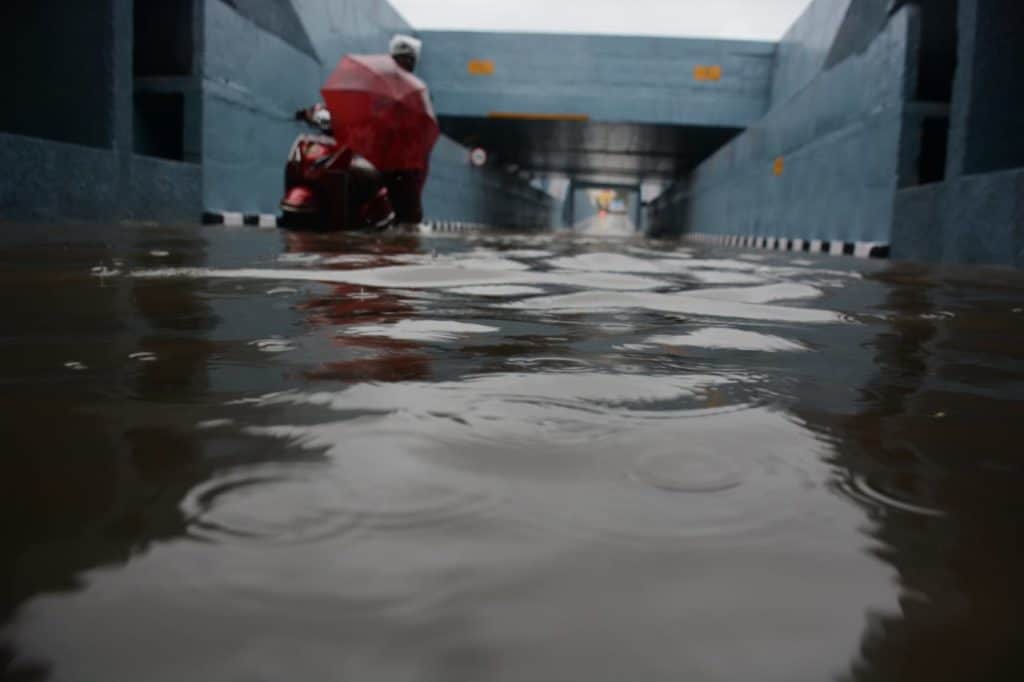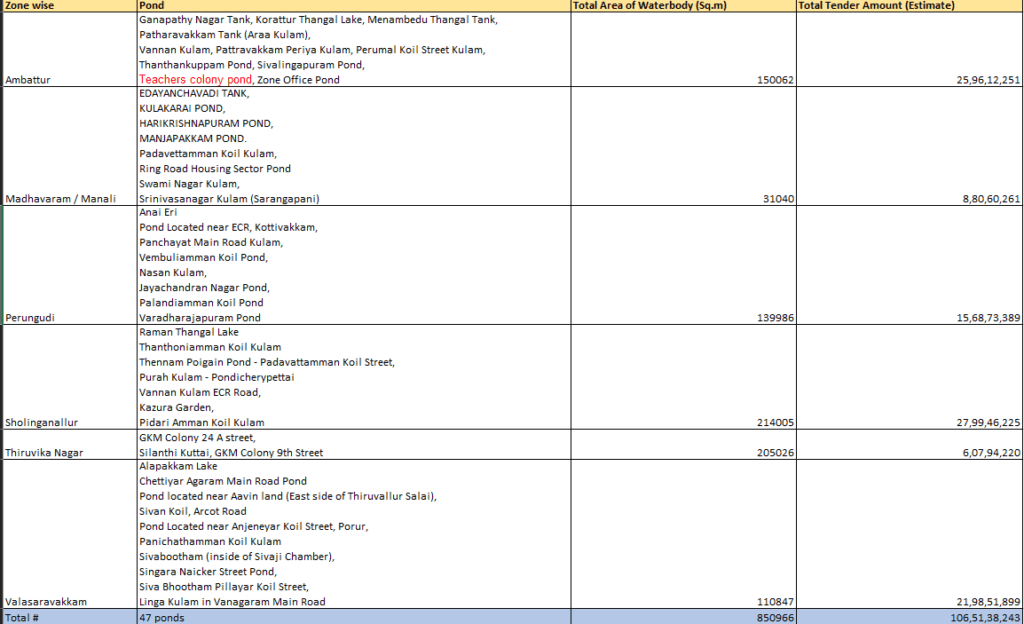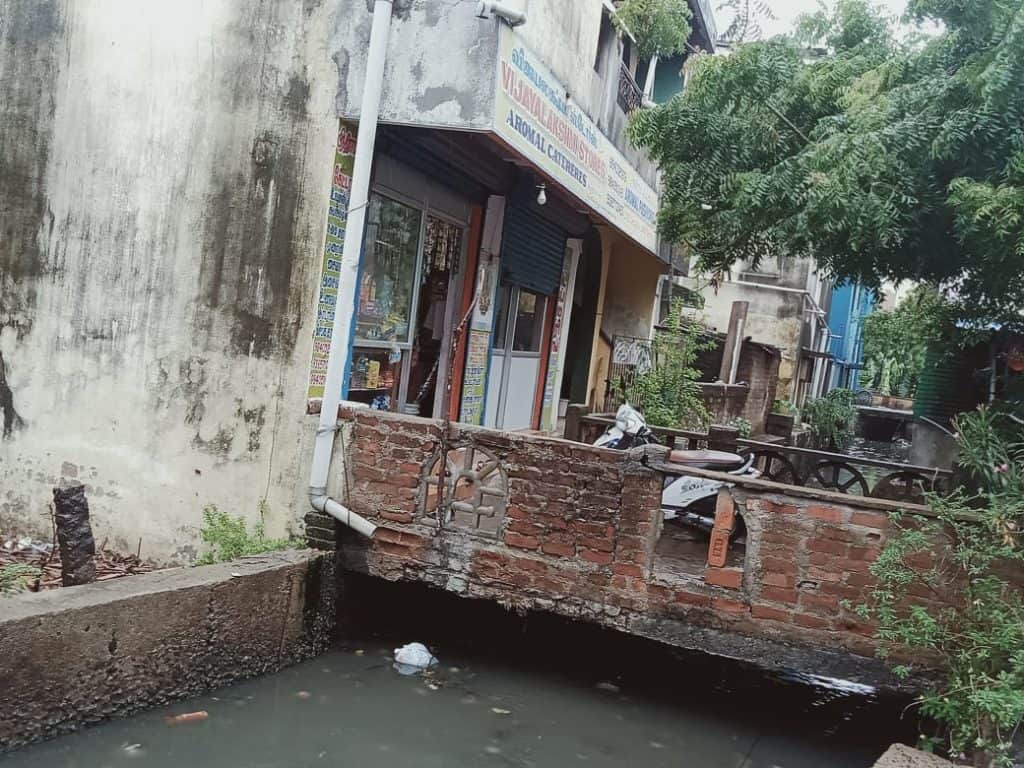A couple of days back, we had written about the areas in Chennai that are particularly prone to flooding and have even been identified by the Greater Chennai Corporation as ‘vulnerable’ in a list that they prepared in 2018.
But it has been two years since then, and the city continues to be under threat of increased instances of intense rainfall, as highlighted by several studies and research. What is the civic body doing to prevent inundation?
As part of flood mitigation measures, the GCC is constructing an integrated stormwater drain (SWD) network in the Kosasthalaiyar Basin in North Chennai and in the Kovalam Basin in South Chennai. This is expected to protect the urban poor and vulnerable population from flood risks.
The project, funded by the Asian Bank of Development, is aimed at improving the flood protection mechanism by enhancing drainage along the roads, canals and rejuvenation of water bodies.

However, there are several instances that point to the fact that the civic body is mismanaging infrastructural projects, leading to increased flooding risk. For example, it has been reported that the civic body is executing a stormwater drain (SWD) project worth Rs 440 crore without even a map of the network. Now, as it nears completion, the Corporation plans to appoint a consultant to evaluate the project and prepare a map.
The pandemic has also played spoilsport as far as flood mitigation projects are concerned. “We had to halt all the projects till June, as the prime focus was to keep COVID-19 under check,” said a source from GCC.
Under the circumstances, there are a few things that the local government must address on a war footing, say experts.
Finish lake restoration work

The work for many water bodies remains uninitiated, or paused, due to various reasons. Kannathamman Kovil Pond near Ambattur Zonal Office, Pattaravakkam Tank (Arra Kulam) and Vannan Kulam in Ambattur are a few of the ponds where restoration activity has not been completed yet.
The channel that carries excess water, construction of dhobi ghats, stormwater drain with collection pit, recharge well and a retaining wall are some of the incomplete works in these ponds, which are necessary for a flood-proof monsoon.
Besides pending work, there have also been instances of faulty restoration. For example, new bunds were formed for the Ramapuram lake that underwent restoration recently, without demolishing the concrete buildings on its bed and clearing encroachments. It is to be noted that the modus operandi of water body restoration should include marking of boundaries at the very outset.
“The faulty restoration of the lake poses a huge risk during episodes of heavy rainfall, as water discharge capacity will not be up to the mark due to the presence of encroachments,” says Jayaram Venkatesan of Arappor Iyakkam.
Ensure smooth flow of waterways
Waterways, that is, inlets and outlets of water bodies, should be free from blockages to prevent the excess water from entering residential areas. Canals in Ambattur, Adambakkam and Pallavaram in the city are riddled with encroachments that hamper the free flow of water.

“The presence of concrete structures on the lake channels is the primary reason behind Pallavaram and Chrompet neighbourhoods getting flooded even when the rains are not intense. If the channels are unclogged, the excess rainwater can reach the Pallavaram Periya Eri,” says David Manohar, an activist from Chrompet.
After the episode of flooding in July 2020, Chengalpet District Collector and officials from Public Works Department (PWD), Revenue and Municipal visited the locality and concluded that the encroachments ought to be removed so as to deepen and widen the channels. Residents have made multiple representations in the past over these issues, and authorities make regular visits after every complaint.
Despite several pleas, official inspections and disastrous monsoons, not much has been done yet to fix the issue in these suburban areas.
SOLUTION TO PREVENT FLOODING ON ENNORE CREEK
Researchers K Murali, SA Sannasiraj and V Sundar of the department of ocean engineering at IIT-Madras suggest building ‘straight training walls’ at the mouth of the Ennore Creek to direct the flow of a river. The training walls secure the creek entrances, keeping them steady and minimises the accumulation of sediments to prevent floods.
“It is important to note that due to current design of cooum training walls and its implementation, sand continues to accumulate leading to flooding of the areas around Cooum banks during 2015 floods due to improper drainage,” the research team said.
India Adaptation Strategy Head for the Climate Resilience Practice and World Resource Institute (WRI) India, Dr Arivudai Nambi Appadurai says that the city has lost most of its wetlands to indiscriminate planning and rampant real estate activities. Henceforth, urban planning should be done in such a way that does not disturb the waterways and improves the storage capacity of water bodies.
Build and clear stormwater drains
Proper stormwater drain networks must be an integral part of urban planning and of flood prevention in particular. The civic body maintains SWDs that run for 2,058 km. Under the smart city mission, SWD construction has been initiated over another 48.28 km in 141 locations. According to a civic body official, the work in 123 locations (42.90 km) has been completed and it is nearing completion in 19 locations.

Several pockets of Ambattur zone witness flooding every monsoon. Even though the neighbourhood falls under the limits of GCC, several streets do not have an underground drainage system.
“There are many encroachments in the SWDs. For instance, we have reported encroachments on SWDs near the park in Secretariat Colony multiple times, but it has not evoked any response,” says R Ramalingam of West Balaji Nagar Association in Ambattur.
There is also confusion over fixing accountability for the maintenance of stormwater drains. The sewage from West Balaji Nagar that flows into the SWDs drains into the Puzhal Lake. “Officials from the Chennai Metro Water Supply and Sewerage Board (CMWSSB) had made a field visit two years ago but nothing has been done so far to arrest the sewage inflow into the lake. We do not know if the responsibility lies with GCC or CMWSSB,” Ramalingam adds.
Get sewage systems in place
Sewage getting mixed in storm water drains and eventually ending up in lakes is not a one-off problem, but is a reality across Chennai in areas like Korattur, Adambakkam, Madipakkam and Selaiyur.
A few years ago, several localities were added to the Greater Chennai Corporation. But underground drainage system project in many of these areas, such as Sholinganallur, Perungudi, Thoraipakkam, Kottivakkam, Neelangarai, Korattur and Ambattur, are either absent or underway.
What has this meant for these areas? Every monsoon, DTP Colony in Ambattur is flooded. “Underground drainage is a failed project here. Sanitary waste from many households regularly flow into the storm water drains, due to the absence of a proper sewage network and pumping station. This has been happening for the past 15 years,” says Banu Viswanathan, president of Prithvipakkam Residents’ Welfare Association.
Streamline solid waste management
Starting October 1st, the civic body has roped in a new waste contractor, Urbaser Sumeet, for collecting and transporting the waste generated in seven zones. Jayaram, however, feels that 95% of garbage would end up in the Pallikaranai marshland under the new contract, due to the lack of sufficient facilities.
“About 35% of the waste can be recycled for which the city needs large material recovery facilities. At present, only 1% is being recycled. Similarly, 50% of the waste can be composted, and the tenders were only floated recently. The civic body should have invested at least Rs 1,000 crore for developing the infrastructure and the contract with Urbaser should have been signed later,” Jayaram adds.
ALL THE PROBLEMS ARE EXPLAINED CLEARLY.THE CORPORATION AND GOVERNMENT SHOULD MAKE STEPS TO OVERCOME THESE PROBLEMS.WE ALL ASSOCIATION URGE FOR THIS.
Talking about flooding problems during peak monsoon period is somewhat ILLOGICAL. All the problems highlighted need to be corrected by civic authorities on routine basis. However, flooding during rainy days can be instantly avoided, by the civic authorities identifying the sloppy areas on the Lanes, Streets, Roads, Water bodies, etc. and to create RAIN WATER HARVESTING PITS. To create RWH systems on the above mentioned places doesn’t require any huge funds even, just with available human resources and regular funds RWH systems can be established, to overcome rainy days woes. IF THERE IS WILL THERE WILL BE WAY.